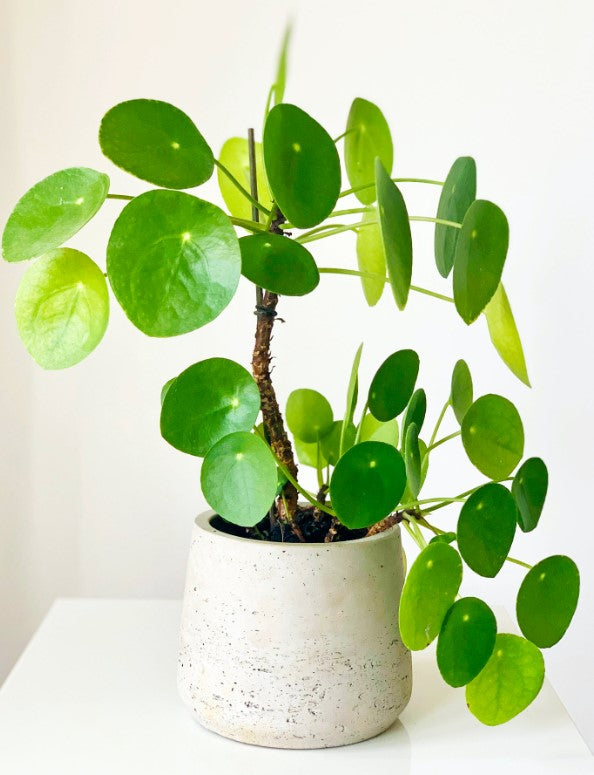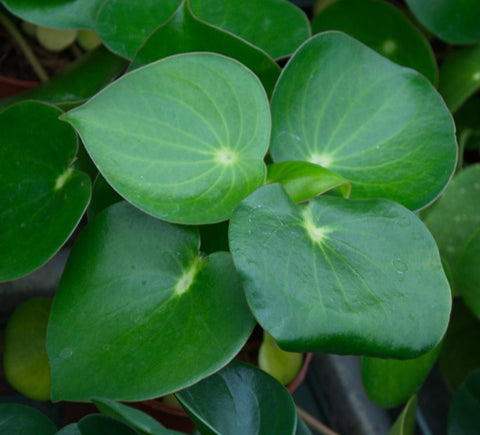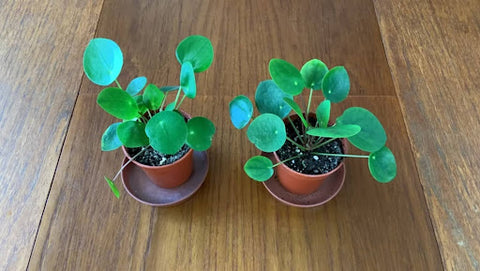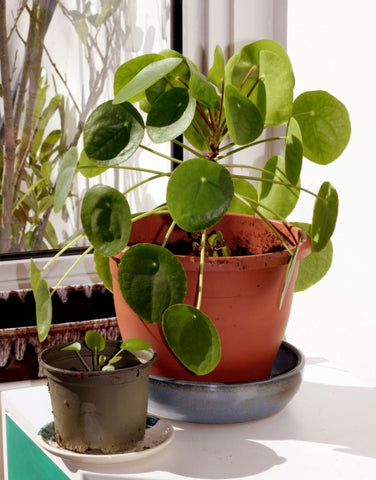Welcome
You have points
Recently viewed
No recently viewed items
Wishlist
Sign in to access your favorites

The Chinese money plant, or Pilea peperomioides, is a popular and easy-to-care-for houseplant, hailing from the Yunnan and Sichuan provinces in Southern China. Known for its unique coin-shaped leaves and symbolic association with prosperity, it makes sense to propagate this elegant plant and share it with family and friends.
But how to propagate a Chinese money plant indoors?
In this article, we'll master the art of propagating a Chinese money plant in three proven and easy ways - from offshoots (pups), from main stem cuttings, and leaf cuttings.
So, let’s get started without further ado.

Pilea peperomioides is known under various names, such as friendship plant, pass-along plant, and pancake plant, among others.
A popular houseplant among indoor gardeners, this evergreen perennial plant can easily be distinguished by its shiny, dark green, and UFO-shaped leaves that can expand up to 10 cm in diameter. This air-purifying plant has the ability to grow as tall as 30 cm in the wild.
Propagating a Chinese money plant is a good way to manage its size to promote healthy growth, as well as to expand your indoor greenery.
Yes, you can propagate a Chinese money plant successfully, without much effort. To do so, you can use the following three methods:
Which technique you’ll apply will depend on the size of the plant and whether it has developed strong young pups showing through in the pot.
The best time for Pilea peperomioides propagation is in its active growing period, in the spring and early summer. Consider it a golden window for your Chinese money plant’s maximum growth.
But you can also propagate your houseplant at other times of the year, as long as you provide the new baby plants with the right lighting conditions, temperature and humidity.
Gather the following tools and supplies for a successful Chinese money plant propagation:
Tools & supplies:
Important: Ensure that you use a sterilized knife by cleaning it with either ethanol or isopropyl alcohol before cutting to prevent the potential spread of disease-causing pathogens.

Let’s dive deeper into the three techniques mentioned above and learn how to propagate a Chinese money plant, starting off with the offshoots (pups) method.
Propagating a Chinese money plant from its offshoots (pups) is probably the most straightforward method out there, as discussed below:
Note: This technique is often referred to as 'division propagation' since you cut each baby plant from the mother plant and root it independently in a fresh batch of soil.
The second reliable method for propagating a Chinese money plant is through a leaf cutting. But here’s a catch. The end of the leaf must be attached to a portion of the main stem of the mother plant; otherwise, it’ll rot.
See below the detailed steps of growing baby money plants from leaf:
The main stem technique is the fastest route to Chinese money plant propagation and works best for plants with a tall stem and heavy top.
If your plant looks exactly like this, follow these steps to propagate it:
This propagation technique is ideal if you want control the size of the mother plant, which will grow new foliage and have a more bushy appearance.

The offshoots or small baby plants demand twice the care of their parent plant to thrive. Ensure you’re on the right caregiving track with these aftercare tips:
Take good care of your Chinese money plants and they’ll grow into strong and vibrant mature specimens.
A: Removing Chinese money plant babies, or pups, is a personal preference and depends on the plant’s overall size. If it’s too tall and growing out of control, removing the offshoots can help control its size. You can also use these babies to propagate new plants and expand your indoor plant collection.
A: Your Chinese money plant may be unhappy if it's not getting the right amount of light, water, moisture, and nutrients. Hence, it’s important to meet all of its care requirements to enjoy a thriving green companion.
A: Yes, a Chinese money plant is not toxic to cats and dogs. Hence, you can safely grow and propagate this popular pet-friendly plant at home without risking the well-being of your furry friends.
A: Pilea can be propagated in both water and soil. The best idea is to grow it in water for a short period, say a week or two, to help the roots establish before transferring the plant to a pot with soil.
A: Pilea cuttings usually root within two weeks, provided they get adequate care. Still, it may take a baby money plant a good month to properly develop its root system in soil.
By learning how to propagate a Chinese money plant, you can multiply this beautiful tropical houseplant and spread the joy of plant parenthood with family and friends by giving them a thoughtful plant gift.
With patience, care, and some botanical knowledge, even a novice can successfully propagate this beloved plant, fostering a sense of abundance and prosperity for years to come.
Want the best companion plant for your Chinese money plant, which is one of the luckiest plants in Feng Shui? Pair it with a ZZ plant or snake plant or a money tree to promote good fortune and financial wealth!